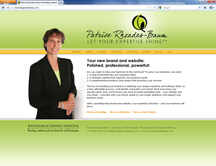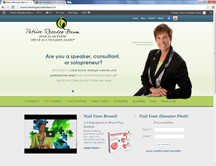Archive for the ‘Website Tips’ Category
How to ask for (and get) client testimonials
Your clients love teaming with you. When you ask for testimonials, they happily agree. BUT …
- They are crazy-busy.
- They don’t get around to it.
- They forget.
- You are uncomfortable reminding (and pestering) them.
Sound familiar? You’re not alone! Getting client testimonials is a universal challenge for small business owners.
Here is the key issue: You are giving them an action item
When you ask for testimonials, you are giving clients an action item. They mean well and intend to give you a glowing testimonial.
However, that action item gets lost among other high-priority tasks. It may literally get lost in a sea of scribbled notes on their desk!
Here are solutions: My favorite tips to ask for (and get) testimonials
Over the years, I’ve acquired a variety of methods to request testimonials for my marketing consulting business. Plus, I’ve helped several clients by interviewing their customers for audio testimonials. Here are my favorite tips.
1. Jot down notes when clients rave, then write the testimonials for them – This has become my favorite method. Often, a client will enthusiastically share comments such as “I really like working with you because…” or “I’m so tickled how well this project turned out…” If your client gushes, grab a pen and jot down notes. Later, email the comments and ask for permission to publish this as a testimonial.
2. Convert emailed comments into a testimonial – After converting their comments into a draft testimonial, email this draft to your client and ask them to review/approve. Often, they will elaborate and give you an even better testimonial!
3. Request an audio testimonial – You can ask permission to interview your client and set up a conference call. Then you (or a colleague) can conduct a brief interview. For an example, listen to audio testimonials I created for Claire Hatch, a marriage counselor in Seattle. (In addition to the audio, be sure to include a snippet of the testimonial on your “Testimonials” web page.)
4. Call and ask for a testimonial, on the spot – Extroverts may embrace this tip more readily than introverts! Simply call your client, explain that you’d love a testimonial, ask if he/she has a minute, discuss the project AND results, and write (or type) notes.
Edit this into a brief testimonial. Ask clients if they want to read and approve the written testimonial. This can be an extremely streamlined way to acquire hardworking testimonials.
Bonus #1: You have enough fodder to write a case study!
Bonus #2: Call past clients and let them know you are updating your website and would love to add their testimonial, with a link to their website. This phone call offers an excellent opportunity to reconnect with “old” clients, rekindle your relationship, and possibly identify new opportunities to work together.
Read More...
Checklist: How to edit client testimonials to ensure they are professional and hardworking
As Captain Renault (Claude Rains) says in Casablanca, “I’m shocked – shocked!” when I hear certain “truisms” about running a small business.
Here’s an often-repeated “truism”:
Never edit a client’s testimonial; you must use it as is, including typos.
“I’m shocked – shocked!” whenever I hear this. I’ve been a professional writer/editor for more than 30 years, and I would never publish something in a website, brochure, or speaker one-sheet that contained typos, poor grammar, or run-on sentences.
Keep these guidelines in mind:
- You can edit and polish testimonials with a light touch, so you don’t change the meaning. Ensuring they are “clean” is important for overall professionalism.
- You can sprinkle in keyword phrases to enhance SEO and make the testimonials work harder for your website.
- You can flesh out the clients’ full name, title, organization, industry and location, as appropriate, to convey more information and more credibility.
How to edit client testimonials: Here is a checklist to edit and organize your customer testimonials:
- Carefully proof to fix typos and more – It’s vital to fix typos, because this reflects on your professionalism. Correct all grammar and punctuation issues. Shorten run-on sentences. Get out your red pen, and don’t be shy!
- Shorten long testimonials – The goal is to have a variety of short testimonials that get to the point and are easy to read. My mantra is: “You have to be cruel to be kind.” If a testimonial is quite long, I suggest cutting it to just 3-5 sentences. That means sacrificing some content. But this is better than having super-long testimonials that people don’t read, because their eyes glaze over.
- You can rewrite a confusing testimonial, then get the client’s approval – If a testimonial contains good content but is confusing or poorly written, consider rewording key sentences. Then email the revised testimonial to your client for approval.
- Consider organization – I like to organize the testimonials to place those with the most impact at the top of the page. Also, consider alternating the testimonials from male and female clients as well as testimonials that address similar challenges.
- Include the client’s name, title, organization, industry or location – Make this testimonial work hard for you! In addition to the clients’ names, add their title, organization and, if relevant, industry or location. For example, if you are a business coach who teams with clients around the world, it’s exceedingly helpful to add the client’s location for every testimonial. (If you are in the healthcare industry, I recommend you show first-name only or initials-only to ensure privacy.) Adding the client’s photo next to the testimonial is a great idea, if this is appropriate for your business.
- Sprinkle in keyword phrases – For example, be sure to include your full name or full company name instead of abbreviations. And you can weave in the name of your product, service, or industry. This helps with search-engine optimization (SEO).
- Make one “standout” phrase or sentence bold – This is especially helpful for readers who skim. Be sure to select different points to highlight; you don’t want every bold sentence to say “they’re great” and “they’re the best” and “what a great team.”
- Create a “Testimonials” page on your website – If you have more than 6 or 8 testimonials, I firmly believe you should have a “Testimonials” page on your website. When you add a new testimonial, place it at the top of this web page, so the content is a bit different every time a website visitor happens to visit.
Read More...
VALUE versus BENEFIT: The “secret” to thinking like a marketer
If you own a business, you have to think like a marketing person. Thankfully, this doesn’t mean acting (or dressing) like the stereotypical used-car salesman!
 The secret? Just use the word “YOU.”
The secret? Just use the word “YOU.”
Throughout your marketing toolkit – your website, speaker one-sheet/brochure, blog posts, and articles – it’s vital to speak directly to “you” (your client) and emphasize the benefits and results “you” get.
Your prospective clients (and audience members) are not focused on you and your company – they are focused on finding the right solution to their problem. Your job is to ensure “what you get” is crystal clear.
How can you do this? Simply restructure sentences in your marketing materials.
Instead of emphasizing “I” or “we” and the value you deliver, use the word “YOU” and clearly state the benefit (“what you get”).
Example #1
- VALUE STATEMENT:
“First, we work with our clients to clarify their challenges, then we create unique programs for them.” [To what end? What is the end goal?] - RESTRUCTURED AS A BENEFIT STATEMENT:
“Prior to your event, we consult with you to understand your specific challenges. This ensures your unique program meets the mark and your desired outcomes.”
Example #2
- VALUE STATEMENT:
“We train sales teams on our trademarked process, so they can hit their quota, month after month.” [To what end? What is the end goal?] - RESTRUCTURED AS A BENEFIT STATEMENT:
“Sales director: Your team will learn a proven process to hit their quota, month after month. You can increase your company’s revenue while driving consistency from quarter to quarter, so you can end the revenue roller-coaster ride.”
Get your red pen – it’s your turn!
VALUE STATEMENT:
“We offer a wide variety of workshops where our expert facilitators lead teams through interactive activities to improve communication.” [To what end? What is the end goal?]
Now, restructure it into a BENEFIT STATEMENT:
_______________________________________________________________________
_______________________________________________________________________
Keep your red pen handy! Take a whack at your Home page copy.
Is your website’s Home page copy chock-full of “I” or “we”? If so, invest a few minutes to restructure value statements into benefit statements. Get in the habit of writing “YOU” to clearly state “what you get”!
BTW, here’s one possible solution to the above exercise:
“In your customized workshop, our expert facilitator will lead your team through interactive – and strategic – activities to improve your team’s communication skills. The goal is to forge a highly productive team built on trust, open communication, and true teamwork.”
Read More...
How to improve your writing: My top 2 tips
 I just got off the phone with a client; we are teaming on an exciting branding and website project. She truly is an expert in her business-consulting niche. Soon, she will be poised to step up as a thought leader.
I just got off the phone with a client; we are teaming on an exciting branding and website project. She truly is an expert in her business-consulting niche. Soon, she will be poised to step up as a thought leader.
We chatted about the importance of blogging, and how her regular blog posts will:
- Support her from a search-engine optimization (SEO) standpoint and help her get found by prospective clients
- Enable her to expound on her topic, educate clients and prospects, and reveal her passion, commitment, and personality
She asked: “How can I improve my writing?”
As a professional writer for 30+ years, I shared my favorite tips:
- Write a short blog post every day or every week. Gone are the days of writing long, daunting, full-length articles for your blog or guest blogs. Instead, write short blog posts (200-300 words). Focus on a key point that is useful or insightful for your readers. Stay on point, and make sure your point is clear.
- Take out your red pen! I firmly believe editing your writing is the best way to improve your writing. Print your draft, then use a red pen (or color of your choice) to edit your content. Read through your copy several times and edit for brevity, spelling, punctuation, grammar and, of course, clarity. Your goal? Copy that is crisp, clear, and compelling!
Speaking of keeping it short…
We have a rollicking thunder-and-lightning storm at my office. Time to turn off and unplug the computer. I hope there are no typos that will undermine my editing advice. :>
Read More...
Case Study: BrandingAndWebsites.com
On New Year’s Day, I resolved that 2013 would be my LEAP Year! By teaming with small business owners for 8 years, I have “cracked the code” on micro-biz branding. My goal is to step up as the Thought Leader on branding for solopreneurs.
The first order of business?
My website needed a significant update and facelift.
To ensure a solid foundation – or a launchpad! – I stepped through my Nail Your Brand™ system, just as I do when guiding clients to clarify their brand.
Here are my Brand Elements™
MY NAME & TITLE
Before: Patrice Rhoades-Baum, Branding & Website Expert
After: Patrice Rhoades-Baum, Marketing Consultant & Branding Expert
TAGLINE
Before: Let Your Expertise Shine!™
After: Shine as an Expert. Step up as a Thought Leader.™
MY PHOTO
Before & After:
The result?
Yours truly believes this new website is more strategic, on-target and dynamic, thanks to starting with a clear brand. What do you think? CLICK TO VISIT.
MY WEBSITE
Before & After:
Read More...
Solopreneur: What does your photo say about you? About your brand?
Put thought into your photo — it’s a vital Brand Element™.
Is your photo fabulous? Does it convey confidence and sparkle with personality?
Or is it a basic headshot? Does it simply portray you as a nice person?
Hands-down, a powerful photo taken by a professional photographer is critical for your business and your brand. If you’re a professional speaker, business coach, life coach, corporate consultant, or other infopreneur, your photo should be featured prominently on your website’s Home page, your speaker one-sheet, and even your business card.
Why? Because YOU are your business. You bring your unique skills, philosophy, expertise, depth of experience, education, and track record to solve your clients’ challenges.
Pictures speak louder than words, so let’s look at examples!
~ BEFORE ~ ~ AFTER ~
 Suzanne Smith, owner of Pilates With Suzanne, personally teaches every class with enthusiasm and expertise. Can you tell?
Suzanne Smith, owner of Pilates With Suzanne, personally teaches every class with enthusiasm and expertise. Can you tell?
 Frances Rios, Professional Speaker and Communication Expert, empowers companies to grow by transforming their employees into Influential Communicators.
Frances Rios, Professional Speaker and Communication Expert, empowers companies to grow by transforming their employees into Influential Communicators.
 John J. Hall, Author & Speaker, presents his “Do What You Can!” 6-step system, empowering audiences and readers to achieve extraordinary results in their business and personal life.
John J. Hall, Author & Speaker, presents his “Do What You Can!” 6-step system, empowering audiences and readers to achieve extraordinary results in their business and personal life.
 Yours truly, Patrice Rhoades-Baum, Marketing Consultant & Branding Expert, guides solopreneurs to create a clear brand, strategic website, and polished one-sheet, so you can shine as an expert — and step up as a thought leader.
Yours truly, Patrice Rhoades-Baum, Marketing Consultant & Branding Expert, guides solopreneurs to create a clear brand, strategic website, and polished one-sheet, so you can shine as an expert — and step up as a thought leader.
Before you update your website or one-sheet, put thought into your professional photo. Remember, it’s so much more than a simple headshot!
Read More...
WIFM drives all your marketing activities, including branding your business
Tip: Read the following with an announcer’s voice:
Your clients are always tuned in to radio station WIFM: “What’s In it For Me?”
Over 3 decades ago, I received this timeless marketing advice — the single most important advice in my marketing career.
decades ago, I received this timeless marketing advice — the single most important advice in my marketing career.
In marketing, WIFM is your touchstone. Do not lose sight of this.
When I presented my “Nail Your Brand!” workshop for NSA’s Colorado Speakers Academy a few weeks ago, we started the workshop by discussing, and underscoring, the importance of WIFM in all aspects of marketing your business.
Obviously, you use a WIFM approach in advertisements. Plus, it’s the approach to use for website copy, your speaker one-sheet or company brochure, and even your brand.
When clarifying your brand, it’s important to communicate who you are and what you do. And it’s critical to convey what THEY get — the benefits and results your clients, customers, and audience members receive.
No matter what type of marketing activity you’re working on, including clarifying the brand for your small business, keep this in mind: Your clients are always listening to radio station WIFM: “What’s In it For Me?”
Read More...
Take 5 minutes to protect your brand
Purchase critical domain names — right now — to protect your brand!
Your website address is vital to your brand — and your business. I encourage you to research and purchase a variety of domain names to protect your brand. Do it right now, if you can. Domain names are ephemeral: here today, gone tomorrow!
1. Buy your name, if you don’t own it
- True story: One of my clients (a consultant and professional speaker) Googled her unusual name and discovered that a woman with the identical name was wanted by the police! What if the “other woman” had purchased that domain name and set up a website? Talk about brand confusion!
2. Buy common misspellings
- Example: CathyDoeSpeaker.com and KathyDoeSpeaker.com
- Ask your developer to set up redirects. This way, someone who misspells the website address will arrive at your website, seamlessly.
3. Buy your book title, product title, your tagline, and other brand phrases
- If you’re writing a book or creating a product, purchase the working title(s) right now. Domain names are here today, gone tomorrow.
- Your tagline is a particularly important Brand Element. Purchase the phrase, so you own it — and no one else will.
4. Buy variations and extensions such as .net, .co, .info, and .biz
- True story: My husband, Michael Baum, is an artist. His website address is MichaelBaum.com. One day a man called and said, “My name is also Michael Baum, and I’m an artist too … I’ve been thinking about setting up a website at MichaelBaumArt.com.” We immediately snapped up that domain name, along with MichaelBaum.net and other variations, to protect his brand.
- Purchasing multiple variations of your main domain name(s) can be costly, so do what you can.
- In addition, purchase your main domain name for at least 5 years, since this is critical to your business and you don’t want it to slip away. In addition, “amount of time owned” is a data point that search-engine robots use when rating your site. (This is logical, since a fly-by-night website operator would probably only purchase a domain name for 1 year.)
Nuts-and-bolts advice:
- In all marketing materials (including your business card), always capitalize the letters in each word in your website address to help readers quickly read and comprehend the words. Example: www.yourbusinessname.com versus www.YourBusinessName.com.
- Your email address should correspond with your website address for professionalism, consistency, and to further support your brand. If you’re using YourName@gmail.com, consider switching to Firstname@YourBusinessName.com.
- I purchase my domain names from GoDaddy.com, because I appreciate their prices and their customer service.
Branding advice: Your website address is a Brand Element™
I consider the website address to be an important Brand Element, because it conveys critical information about your business. Your website address supports your brand by communicating:
- Who you are and what you do
(e.g., CathyDoeSpeaker.com)
~ OR~ - What your clients get
(e.g., SocialMediaBizTraining.com)
Follow the steps above to research and purchase a variety of domain names — right now — to protect your brand and your business!
Read More...
Writing your own website copy? Use my Website Editorial Styleguide
Many of my clients are writing books at the same time they are working with me to clarify their brand and write their website copy (especially professional speakers and corporate consultants).
A couple of years ago, a client’s proofreader saw my website copy and, as a favor to the client, took his red pen to the copy, following the Chicago Manual of Style. Unfortunately, this didn’t do the client any favors. In editing the website copy, he essentially tried to pound a square peg into a round hole – it just didn’t fit.
Website writing is marketing writing
Editorially, some things are different for marketing copy (including website copy) than for books or white papers, where you must strictly follow the Chicago Manual of Style. Now when I give my clients website copy to review, I always preface the copy with my Website Editorial Styleguide.
Writing for websites is different than writing for other marketing pieces
Ironically, we strive for great website copy knowing that no one reads websites! In reality, people skim website content, then sink their teeth into the details once they are snagged by content that is interesting and pertinent to them.
This means the copy must be extremely easy to read. It must be “visual.” And it must be presented in a way that anyone, including skimmers, can grasp the key messages.
Follow this Website Editorial Styleguide if you’re writing your own website copy
- Write hardworking headlines with a benefit statement and, where possible, include SEO keywords
- Sprinkle in a lot of subheads, so skimmers can get the full story
- Keep paragraphs as short as possible, with as few as 2 to 3 sentences each
- Use bullets to present a list of brief, yet important, points
- Present all numbers as numerals (instead of spelling out): 5, 10, 126
- Show symbols where possible: 5%, $10
- Write sentence fragments, where it feels right
- Uppercase titles (such as Professional Speaker & Author) and other stuff that feels important (Strictly speaking, titles don’t “deserve” to be in uppercase except in very particular instances. For website copy, I like to uppercase titles so they stand out to the website visitor who is skimming, not reading. Plus, this does add import.)
- Avoid using italics (Small-point italics can be difficult to read on computer monitors and laptop screens. Also, italicized copy will convert to Roman style when the website developer pours the copy into the website program. This means they must chase down italicized copy and make the changes one by one.)
- Liberally use dashes in the copy, especially in headlines and subheads (Visually, this breaks a phrase or sentence into chunks, making the chunks easy to read at a glance.)
- Use the n-dash [–] instead of m-dash [—] (Website programs don’t recognize the m-dash and will replace a weird symbol in its place. The programs do, thankfully, automatically recognize and translate the n-dash.)
Read More...
Debating between 2 website addresses?
Are you debating between using 2 or more domain names for your website?
One of my clients – let’s call him Dave Smith – asked which website address would better serve as his main domain name:
1) DaveSmithDelivers.com
2) HowGoodLeadersBecomeGreat.com (Note: This is not his actual domain name. I altered it for this blog entry.)
My thoughts:
– Both domain names are easy to say, easy to understand, and easy for prospects and customers to spell.
– Both communicate a benefit, in a distilled manner.
– Both website addresses support the brand we created for him.
– HowGoodLeadersBecomeGreat.com is a bit long, but not a show-stopper for his highly educated target audience. (Always uppercase each word in your website address to make it easier to read.)
A consideration is that Dave wants prospects and customers to easily remember his website address. For example, John says to Mary, “I’ve been working with Dave Smith, and he’s great! You should check him out. What’s his website address? Something about great leaders, but I don’t remember. You’ll need to Google it.”
For this reason, I recommend my client uses DaveSmithDelivers.com as his main website address.
In addition, he should strategically use BOTH domain names, for different circumstances. For example, my client could use DaveSmithDelivers.com as his main website address, plus our developer would set up the other URL as a redirect.
Now, Dave Smith can use the 2 website addresses almost equally. For example, articles and marketing materials promoting his book, workshops, and keynote presentations on the topic “How Good Leaders Become Great” would include the correlating website address. Other marketing materials would present DaveSmithDelivers.com as his domain name.






